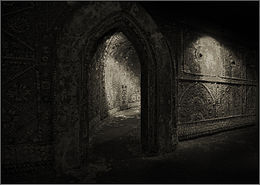- Shell Grotto
-
The Shell Grotto is an ornate subterranean passageway in Margate, Kent. Almost all the surface area of the walls and roof is covered in mosaics created entirely of seashells, totalling about 2,000 square feet (190 m2) of mosaic, or 4.6 million shells. It was discovered in 1835 but its age remains unknown. The grotto is a Grade I listed building and is open to the public.
Contents
Overview
The Shell Grotto consists of a winding subterranean passageway, about 8 feet (2.4 m) high and 70 feet (21 m) in length, terminating in a rectangular room (the altar chamber) approximately 15 by 20 ft (5 by 6 m). Close to its half way point, the passageway divides to pass around a massive circular column called the rotunda. Attached to the grotto is a museum, gift shop, and cafe.
The purpose of the structure is unknown, and various theories have dated its construction to any time in the past 1,000 years, and speculated possibilities of the builders include the Knights Templar. The shells are all local, but some of the designs suggest associations with India and Egypt. The official guide suggests a subject for many of the mosaic panels, such as a skeleton, crocodile, owl, or turtle, but the abstract nature of the designs make these suggestions rather subjective.
History
The grotto was discovered in 1835 by James Newlove, who broke through into its roof while digging a duck-pond. It was illuminated by gas lamps and opened to the public in 1837, and has remained in private ownership ever since.
The age of the structure is uncertain and attempts to use radiocarbon dating to determine the age of the site have failed. Carbon deposits from Victorian lamps which were used to illuminate the grotto in the 1800s have entered the shells. Trying to analyse the mortar proved equally futile, it has so far defied analysis and all that scientists can ascertain is that the glue attaching the shells to the walls is "fish-based".
The Victorian gas lighting has blackened the fragile surface of the once-colourful shells, which are also under attack from water penetration. It is now illuminated by electricity. During World War II the east wall of the so-called altar chamber was destroyed by a bomb.
Bibliography
- The Grotto, Howard Bridgewater, Fourth Edition, Truprint Litho Ltd, 1957
- The Shell Temple, Ruby Haslam, Regency Press, 1974
- The Subterranean Kingdom, Nigel Pennick, Turnstone, 1981, ISBN 0-85500-140-2
- Shell Houses and Grottoes, Hazelle Jackson, Shire Publications, 2001, ISBN 0-7478-0522-9
External links
Wikimedia Foundation. 2010.

